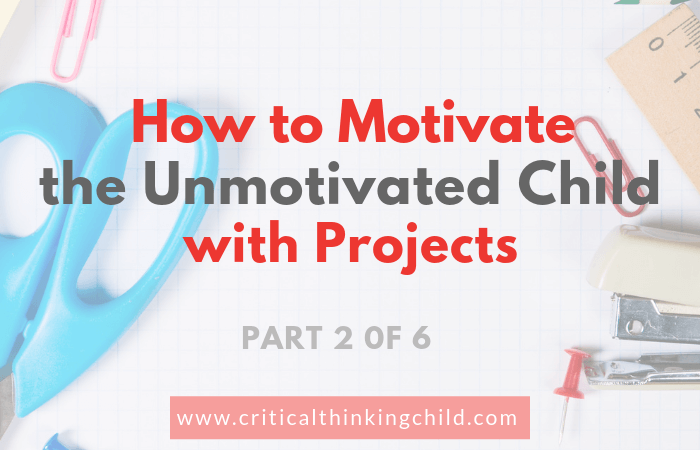How to Motivate the Unmotivated Child (a 6-part series)
Motivating a child who is not interested in learning can be very challenging for a parent or teacher, and only gets more so as children get older. Years of rote learning, worksheets, and silent seatwork can wear on children and cause them to lose their natural curiosity and love for learning. Fortunately, there are some ways to prevent this before it’s too late.
We’ve already talked about how praise can motivate an unmotivated child, and now I want to address a second strategy: projects. Some students are incredibly motivated by project-based learning, so let’s dive into what it is, why it works, and how you can use it to motivate your child.
What Is Project-Based Learning?
Project-based learning is a specific type of learning specifically designed to be student-centered and relevant to the real world. This type of learning is inquiry-based, which means it doesn’t give children answers right away. Instead, students decide what they want to learn about or what problem they want to solve and pose questions around that topic.
From there, the student decides how to go about answering their question, recording their data, and sharing their results. Although the topics and approaches can vary, all projects include an initial hypothesis, a plan for collecting information, and a way to synthesize and share results. Throughout the project, teachers and parents provide help on the side, but students take the lead.
One of the benefits of project-based learning is that the projects tend to relate to the real world. They might even pose solutions to real problems. This brings learning outside of the home or the classroom and shows your child how they can apply their critical thinking skills anywhere.
What Projects Should I Choose to Motivate My Child?
Teachers often design project units around their state and national standards, but parents have more freedom. Project-based learning at home can be entirely child-driven, and geared towards their specific areas of interest.
Maybe your child is fascinated by animals. You could suggest a wildlife watching project at home. You can begin by asking your child what they want to know about the wildlife around them. From there, your child can develop their own project, with you acting as a support. They might decide to go out every day to count the number of birds and squirrels they see. They can record their data, learn which animal they see most often and at what time of day, write or draw what the animals are doing, and develop conclusions about the animals based on this data. When finished, they may choose to show their findings on a poster or PowerPoint presentation, or could even create their own song, poem, or news article about what they have learned. Artistically driven students could create their own “animal galleries” in which they draw or paint the animals they see and record facts about each one.
The key here is that your child decides what they want to learn, how they want to learn it, and the format they want to use to share their learnings. This type of project can also have real problem-solving implications if your child wants to brainstorm ways to make the yard a better habitat for each animal.
If your child isn’t sure what type of project would be most interesting to them, you can ask them what issues are important to them in their school, home, or neighborhood. Perhaps they are worried about the food options in school lunches, or they are concerned about the amount of time each family member spends on phones and computers at home. These types of problems are engaging to students and lend themselves to problem-solving projects. Students can also gain a huge sense of accomplishment by working to solve problems that adults are also working to solve.
Why Do Projects Motivate Students?
Projects are effective motivators for reluctant students because they are so different from the work they are used to at school. Instead of being teacher-driven or rote, projects are student-driven and involve active learning and questions that can’t always be easily answered. This type of inquiry engages students because they don’t have the answers yet; instead, they have to decide how to search for information, which is much more interesting and motivating than simply memorizing facts and formulas. Taking the backseat as a parent or teacher can be stressful, but you’ll soon learn that it’s worth it when students gain confidence in their own abilities.
Another reason projects work so well is because they have real-world implications. Instead of wondering when they will ever need to use what they are learning, projects are by design relevant to their everyday lives. Children will get a sense of ownership in their learning and know that they are contributing to the world, and this type of engagement is an effective motivator.
If you’d like to try project-based learning with your unmotivated child, start by asking them what they’re concerned about or what topics they’d enjoy diving into. From there, guide them through asking questions, and allow them to take the lead as they determine how to answer them and present their findings. You may soon find your child has become a deeply motivated learner.



